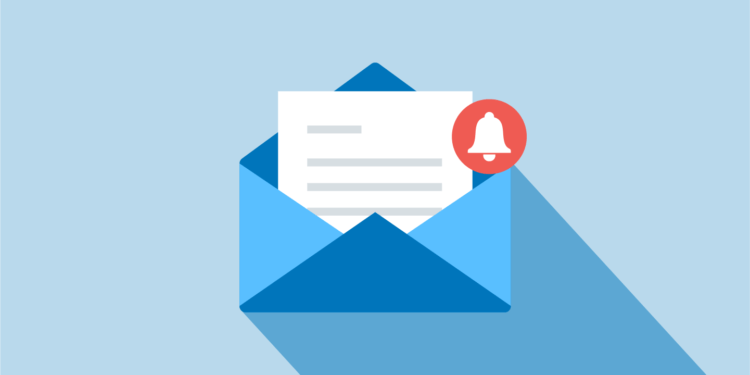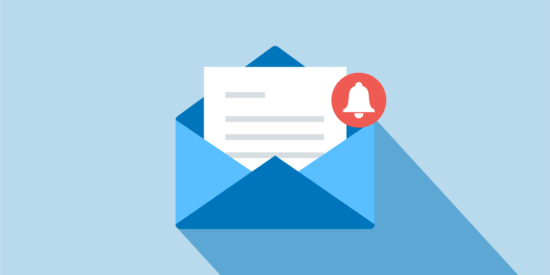Think about your personal email inbox: when you receive a regular newsletter with useful or interesting information, you open it. You may even save it for later reference. When you receive a sporadic, boring newsletter, you delete it. Law firm newsletters are no different. They need to add value for your audience or may end up deleted and forgotten.
Maintaining strong relationships and establishing trust is key to a law firm’s growth, reputation, and success. Law firm newsletters can be an effective way to stay in touch with clients, build trust, and share news—but only if they’re done right.
In this post, we’ll show you how, when, and why you should write and send an effective law firm newsletter that recipients want to read. We’ll also explain how email marketing software makes it easier to send and track the performance of your law firm newsletter. Once you’re equipped with the right tools and know-how, your newsletter will become a great way to build your network, promote your services, and grow your brand.
Why start a law firm newsletter
The cost-benefit of law firm newsletters is hard to pass up. Here’s why:
- It’s an inexpensive, targeted way to reach your target audience. Email marketing is a proven method for promoting products and services online in any industry—including legal. Social media is too noisy and crowded to get your word across. Snail mail is too slow and expensive. Phone calls or text messages are too invasive. When done right, email marketing is personal and private, but not overly annoying or intrusive.
- It can help build your brand over time. The more frequently people hear your firm’s name and interact with you, the more likely they will remember you when they are ready to hire a lawyer or refer one to a friend.
How do I write a legal newsletter?
Map out who your audience is, how often you’ll send your newsletter, what content it will contain, and who will write it. Then, pick a reputable email marketing software and follow email rules in your readers’ jurisdiction. After that, you need to build your email list by getting subscribers. Read on for more details on the aforementioned points, tips for creating the most effective law firm newsletters, and how to set goals and track results for your newsletter.
Who should you send your lawyer newsletter to?

You need to know who you’re sending your lawyer newsletter to. This is fundamental to starting a law firm newsletter. It also ensures you aren’t breaking any anti-spam laws or marketing laws.
Your target audience will likely be your clients, past clients, other legal industry professionals, or a mix of all of the above. Once you know who you want to read your newsletter, you can better tailor the content to make it useful and interesting to the newsletter’s readers.
Whenever a lawyer uses email to communicate with clients, they need to be careful to know and follow the correct rules—even when emailing a lawyer newsletter.
Have a clearly defined audience
It’s also important to have a defined, subscribed audience when building your mailing list according to the rules for email marketing in your readers’ areas. In some cases, for example, your readers may need to opt-in to receive your lawyer newsletter. In the US, it’s important to know and follow the rules of CAN-SPAM Act. Before sending your newsletter, be sure to also observe and meet the correct anti-spam laws and marketing rules for your readers’ jurisdiction. In the US, it’s important to know and follow the rules of CAN-SPAM Act. How often should you send your newsletter?
Communicate consistently
Consistency is the key to establishing brand recognition for your law firm, which is ultimately what you’re going for by starting a newsletter for your firm.
Create a schedule and do your best to stick to it. By sending out law firm newsletters regularly (once a month or once a quarter are good goals), your audience will grow to know when to expect it—which may encourage them to read it (or even look forward to it!).
Be realistic about how often you can regularly put together an accurate newsletter with high-quality content. Remember that someone needs to write it. Whether the writer is you, a staff member, or an outsourced legal writer, someone will need to allot time to create the newsletter, so choose a manageable timeline.
You may like these posts
How to write a law firm newsletter

You’ve figured out who will write your law firm’s newsletter, who you want to read it, and how often you want to send it out. Here are the four basic steps for creating your first newsletter:
1. Customize your template
If you’re using email marketing software like Mailchimp (more on email marketing software below), creating a professional-looking email newsletter is easy. With great email marketing software, you should be able to choose a pre-designed template. Customize the template to your firm by adding your logo, changing the color schemes, and adding text boxes, videos, images, buttons, and other types of content. It’s a good idea to include your logo and some images to make your newsletters more engaging.
2. Add your content
With your basic template set up, the next step is to add the actual content (We’ll have tips on what to include in your newsletter in the next section.). This should include some text (but not too much), as well as images, links to your website, your social media accounts, and more.
3. Preview and test
It’s always a good idea to preview your newsletter and send yourself an email test to make sure you didn’t make any mistakes. Mailchimp has a built-in preview feature to see what your newsletter will look like on different types of devices.
4. Send it out
Finally, when your template and content has been finalized, and you’ve double-checked to make sure you didn’t make any mistakes (be sure to proofread!), you are ready to send out the newsletter to your email list.
What to include in your newsletter

What should you include in your law firm newsletters? The content of each newsletter should vary to keep readers interested and offer value. After all, you want to give your readers a reason to open your email. Remember: The best kind of content to put into your newsletter is something that your readers will find useful.
The key is to remember your audience and your goals. If the majority of your newsletter subscribers are new clients, you might want to focus on things like case studies to showcase your firm’s area of focus. If your newsletter reaches mostly existing or ongoing clients, you might include updates to changes to the law that might impact them. Whatever you include, be sure to make it clear that your email contains newsletter content—and shouldn’t be mistaken for legal advice.
Start with some of these types of content
Consider a mix of the following types of content, depending on your firm’s focus and your attorney newsletter’s audience:
- Case studies. Showcasing successful or interesting cases that your firm has worked on is a great way to grab readers’ attention—since people love to read real stories. This way, you can also highlight your firm’s expertise and credibility. Make sure you never violate client confidentiality—always omit identifying factual details.
- Listicles. Easy-to-skim content tends to get read, so listicles (like numbered or ranked lists of ideas, like “10 Best Law Firm Newsletters”) tend to be a useful way to quickly share interesting or useful information. Listicles are also faster to write than longer-form content.
- Newsjacking. Newsjacking” describes the concept of adding your thoughts or ideas to a trending news topic to create new content. For your law firm newsletter, you could use the idea of newsjacking to write about a topic relevant to your firm. For example, if there’s a prominent policy change or lawsuit in the news, you could use that to create content that relates to your firm.
- Attorney profiles. People love learning about people, so a quick profile of a new lawyer or staff member at your firm is a great way to connect with your readers Whether it’s a Q&A or interview format, including details about their training, their legal background, and their interests.
- Video content. Your newsletter doesn’t have to be all written content. In our digital age, short video content is easy-to-digest for your audience. Consider outsourcing video production to an experienced team within your budget. Be sure to keep the content on brand and useful (i.e. a video explaining a new law change is more useful than a video promoting your firm).
- Curated content. Show your expertise and save your newsletter subscribers time by creating curated content roundups on topics of interest. If you know that your audience might be interested in a new regulation, for example, you could research the five best posts about that regulation, and then create a curated list with links to each.
- FAQs. Do you get a lot of the same questions over and over? Answer the question in your lawyer newsletter. Since many people have the same question, you’re likely providing useful content to your subscribers while showing your expertise. And, as a bonus, you might save yourself from having to answer the same question in the future!
- Changes in the law. If there are any new updates or upcoming changes to the law that may impact your audience, your newsletter is a great place to briefly explain them to your readers.
- Educational guides and resources. Does your firm have a blog? Have you created a guide or free resources that may be of interest to your clients or legal industry colleagues? Link to these resources in your law firm newsletter to add value for subscribers.
What email marketing software to use

Many beginners make the mistake of thinking they can just BCC a few hundred contacts on an email newsletter sent through their normal email account. This is a surefire way to get your domain blacklisted for sending spam. (Remember: You must follow email rules in your readers’ jurisdiction before just sending out emails.)
Email marketing software can help you:
- Send professional-looking emails. Pre-designed templates and layouts let you focus on creating the content, while delivering a polished email newsletter to your readers.
- Manage your contacts. If you have multiple audiences for different versions of your newsletter, email marketing software can help you stay organized. You can even have different email lists so you send only the most relevant content to the right audience.
- Track your email’s effectiveness. Analytic tools and reporting can give you data on what’s working—and what isn’t—so you can adjust future lawyer newsletters to deliver what your audience wants.
There are many email marketing software options, but Mailchimp is among the most popular. Not only is it free up to 2,000 contacts, but it is also easy to use. They also offer tastefully designed email templates which are great for non-designers and if you’re new to email marketing. Because Mailchimp integrates with Clio Grow, using Mailchimp for your email newsletter makes it easy to sync law firm contacts, track leads, and monitor growth that arises from your law firm newsletter.
You can also consider other email marketing options like Constant Contact, AWeber, or Autopilot. Each one has something unique to offer, so do your research upfront to determine which one will meet your specific goals the best.
How to build your law firm email list
Your law firm newsletter’s email list is as important as the newsletter itself. The more subscribers you have, the more people you can reach—and the larger your potential network for new clients and referrals will be.
But you shouldn’t just throw everybody onto one all-encompassing email list. Instead, target your law firm newsletters based on people’s specific interests, or their relationship to you. The more relevant your content is, the more your message resonates with the reader, the more engaged they will become with your firm, and the less likely they will unsubscribe.
For example, if you are a transactional attorney providing estate planning, business, and real estate services, you may split your email list based on those three segments of your practice. This way, you aren’t sending out irrelevant estate planning content to your business or real estate contacts, and vice versa.
Once you have created your lists in your email marketing software, here are the two main ways to start adding people to the lists:
- Add people to your list manually
All email marketing software should offer the ability to upload contacts in bulk from a spreadsheet. But there are a few things to be aware of when manually adding people to your email list. If you are adding them yourself, you need to have their permission first—so be careful about who you are adding to avoid spam complaints (and be sure to know the specific rules for your jurisdiction).
You may want to consider using automation to keep your email lists up to date.
For example, Clio Grow’s Mailchimp integration lets you tag and categorize your contacts and send them to a corresponding email list automatically when they are entered in your CRM database. This eliminates the need for double data entry. You could also use a tool like Zapier to streamline this process.
- Get email subscribers from your website
Building email lists organically from blogs and websites requires a lot of work, but it is also an effective marketing strategy because you don’t have to do anything to manage your lists. Your network will also begin growing on its own.
To start getting email subscribers from your blog or website, you need to:
- Embed signup forms to capture people’s contact information (name and email)
- Produce a steady stream of helpful content to generate web traffic and subscribers
Mailchimp and most other email marketing software will give you the option to embed a signup form on your website. You can just copy/paste the embed code into various pages of your website or blog, and this will enable people to easily opt-in to your mailing list.
If you use WordPress, there is also a free Mailchimp plugin you can install.
Still, getting people to subscribe takes a bit of work. The best strategy to get email subscribers is to start a law blog and publish high-quality content frequently. If you come across as helpful and demonstrate that you are an authority on a certain topic, people will be inclined to subscribe to receive future updates.
Offering “gated” and free downloadable templates or how-to guides in exchange for an email address is a great way to encourage people to opt-in to your mailing list. It can also be an excellent strategy for law firms due to the inherent value in your knowledge.
Top tips for creating the most effective law firm newsletter

Want to make your law firm newsletter the best it can be? Keep it clear, readable, and valuable to your audience with these top tips:
- Write in plain English. Keep the legal jargon and complex language for the courtroom. It won’t impress your readers, and may even make them unsubscribe. Instead, write and explain complex cases simply—this is the value that you and your lawyer newsletter can add.
- Proofread. You don’t want obvious typos or grammatical errors to take away from your authority. Proofread and double-check for errors before hitting send.
- Be brief. It’s a newsletter, not a novella. Keep the content concise, and break things up with headings, lists, and images where you can.
- Showcase clear design. The look of your newsletter matters, too. Professionally designed templates via email marketing software can help with this. But keep in mind that you want your newsletter to look consistent (using only a few fonts, colors, and styles), uncluttered (don’t try to jam too much content in a small space), and visually pleasing (no one wants to read a big wall of text—use pops of color, images, and contrast to break things up).
- Add value. The point of law firm newsletters is to build your brand, showcase your expertise, and give readers something of value that’s worth opening—it’s not a sales email. With this in mind, resist the urge to get too “salesy” with your lawyer newsletter. Instead, include content that you know your audience wants—whether you write it yourself or whether you’re curating articles.
- Be open to questions. While you don’t want to use your newsletter to sell your firm, you can (and should) invite readers to contact the firm with any questions. This is a less pushy, more organic way to drive business.
How to set goals and track results for your law firm newsletter
In the end, creating a law firm newsletter requires effort. That’s why it’s important to know what you want to achieve by sending it out and tracking how well you achieve those goals. While the core goal of your lawyer newsletter is to slowly build your brand and your audience’s trust in your brand, you can also set other long-term goals for your newsletter—like helping to secure new customers, secure repeat customers, build your profile, or get media mentions.
These types of goals are a long game and can be challenging to mark as “achieved” (you won’t see quick, direct results in the form of sales like you might with an ad), but you can track them with the right tools. CRM software like Clio Grow, for example, can help you see the source of leads—so you can monitor growth that arises from your law firm newsletter.
Conclusion
Reaching your clients and building your brand doesn’t have to be complicated or costly—thoughtful, consistent law firm newsletters can do the trick. By following best practices and using tools like email marketing software to help, you can create a lawyer newsletter that gives your clients and legal industry peers useful content, while also establishing your firm’s brand, building trust, and creating a way to share firm news.
We published this blog post in January 2021. Last updated: .
Categorized in: Marketing








